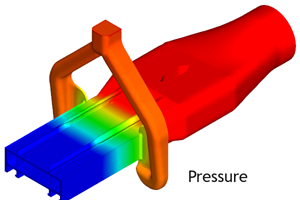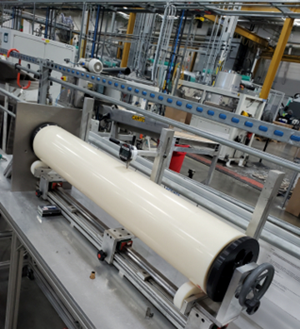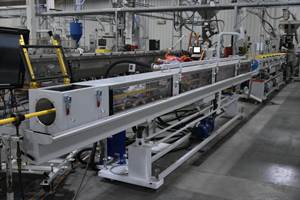Tooling Know-How: Five Tips on Profile Die Design
A poorly designed profile die—one that does not permit the part to be extruded with the same dimensions from run to run—coupled with a lack of understanding of the extrusion process, is a recipe for scrap generation.
A poorly designed profile die—one that does not permit the part to be extruded with the same dimensions from run to run—coupled with a lack of understanding of the extrusion process, is a recipe for scrap generation. There are five things profile processors need to know about designing and maintaining a replicable tool:
•Proper land length: This is the area of steel that runs linear to the profile that gives “memory” to the desired shape of the part. If the land length is too short, the flow will change with any change in the run conditions. Land length also helps offset any swell of the thermoplastic as it exits the die lip. Profiles with an equal wall thickness should have a minimum land length 10 times the intended wall thickness, for a land-length ratio of 10:1. If the intended final wall thickness is 0.100 in., the land length should be 1 in.
Of course this formula does not apply universally. For example, when running a thin-wall profile (say 0.40 in.) of rigid PVC or another high-viscosity polymer, a 10:1 ratio would result in a land length of 0.400 in., which could result in excessive pressure buildup. From a safety standpoint, the maximum continuous backpressure desired is 5000 psi.
•Land length ratio: On profiles with unbalanced wall thickness—i.e., with multiple wall thicknesses in different areas—the same rule applies. Just adjust the land length by removing steel. For example, if one wall is 0.080 in. thick and another 0.060 in., the land lengths would be 0.800 and 0.600 in., respectively.
If you’re running a low-viscosity resin or expect high output rates, land-length ratios can be increased up to 25:1 (Table 1).
| Table 1 Land-Length Ratio Vs. Output (Profile Wall Thickness >0.060 in.) | ||||||||||
| Polymer | Low-Viscosity: LDPE, HDPE, ABS, PP, CAP PET, PETG, HIPS | High-Viscosity: Acrylic, SAN, Rigid PVC, PC | ||||||||
| Expected Output, lb/hr | 100 | 150 | 200 | 300 | >300 | 100 | 125 | 150 | 200 | >250 |
| Land-Length Ratio | 10:1 | 15:1 | 20:1 | 22:1 | 25:1 | 10:1 | 15:1 | 20:1 | 22:1 | 25:1 |
| Table 2 Polymer Drawdown Ranges (Based on a 2.5-in. extruder running at 100 to 125 lb/hr) | |||||||||||
| Polymer | FPVC | RPVC | ABS | HIPS | PC | PET | PETG | CAP | LDPE | MDPE | PP |
| Drawdown, % | 15-30 | 4-10 | 15-25 | 15-30 | 15-30 | 20-40 | 30-100 | 25-30 | 25-30 | 25-30 | 25-40 |
• Drawdown: This is perhaps the most misunderstood concept of profile die design. In profile extrusion, drawdown is the percentage differential between the dimensions of the die as designed vs. the size of the final part. Without any drawdown to exert tension, the extrudate would drape and sag in the sizing medium. Hence, the die designer builds a drawdown percentage into all the dimensions to keep the profile taunt and aligned.
Since all thermoplastics swell, die designers can bring the wall thickness and height dimensions into tolerance with a percentage of drawdown, and if the right proportion is added to the overall dimension, all dimensions would be to specification.
Another little known and rarely discussed concept about drawdown is that the extrudate continues to draw down until it reaches the glass-transition temperature (Tg) in crystalline polymers, or the heat-distortion temperature in amorphous resins. So if a percentage is added to accommodate polymer swell, but the cooling is inadequate to drop the melt temperature to the Tg, the part will continue to draw down, resulting in a smaller than expected extrudate.
Each thermoplastic has a unique specific heat, defined as the amount of heat energy that must be added or removed to change its temperature by a given amount. That affects the rate at which the resin can be cooled sufficiently to prevent further drawdown. This means each polymer has a different drawdown ratio. Thermoplastics such as PP and LDPE are crystalline with a high specific heat and require greater drawdown than an amorphous material such as rigid PVC. This explains why a die designed for PP cannot be used for other polymers. Table 2 shows drawdown ratios for materials running on a 2.5-in. extruder at 100 to 125 lb /hr. A range is listed to reflect different drawdowns for profiles versus tubes and to account for different cooling media.
It’s important to note that amorphous materials such as rigid PVC cannot tolerate large drawdown percentages, as that will impart high residual stresses into the extrudate, causing brittleness when impacted.
•Designing for sensitive materials: When designing for polyolefin profiles, flat-plate dies work fine because they tend to be very stable under heat and do not develop high backpressure. Even flexible PVC, TPOs, HIPS, and ABS can tolerate tools without any great degree of streamlining. Streamlining is the technique of creating generous transitions in the steel without any “dead-spots” where material can burn and degrade. If good aesthetics are required, without any black specks or flaws, it is important not to let any transition create areas where the polymer can stagnate.
•Decompression: Another important aspect of profile die design is to keep the melt under compression throughout the spreader, adaptors, transition plates, and die lip. Any area of decompression will cause problems of material stagnation and ultimately degradation, leading to poor quality. Angles should be kept to 60° (30° included angle)
Whereas the running time on a “flat-back” die can be from one to eight hours with some polymers, a fully streamlined die can run for weeks without stopping to be cleaned out. Profile dies for rigid PVC and PC are especially prone to degradation. For long runs, a fully streamlined die is your best bet.
About the Author
Daniel Cykana has dedicated his 40+-year career to profile extrusion. He has worked in the Advanced Technology Group of Bemis Mfg. Co., Sheboygan Falls, Wis., for the past 32 years, specializing in die and product design and processing. Contact Daniel.Cykana@BemisMfg.com or (920) 918-3250 or extrusionprocessing.com.
Related Content
Updated Software Reduces Die Design Iterations
New software said to reduce the number of fine-tuning iterations and die development time by at least 50%.
Read MorePut Some ‘Lean’ into Your Profile Extrusion Process
With everyone struggling to find talent, there are ways to reduce operator interaction with the process by applying some lean manufacturing principles.
Read MoreTeel Straps on Yellow Belt to Cut Scrap on Big Cores
Investments in a lean, continuous process pay off for this Wisconsin processor.
Read MoreTeel Adding Capacity, Bumping Pay for Hourly Workers
Teel growing to meet market demand, meaning increased employment opportunities for the area.
Read MoreRead Next
People 4.0 – How to Get Buy-In from Your Staff for Industry 4.0 Systems
Implementing a production monitoring system as the foundation of a ‘smart factory’ is about integrating people with new technology as much as it is about integrating machines and computers. Here are tips from a company that has gone through the process.
Read MoreLead the Conversation, Change the Conversation
Coverage of single-use plastics can be both misleading and demoralizing. Here are 10 tips for changing the perception of the plastics industry at your company and in your community.
Read MoreTroubleshooting Screw and Barrel Wear in Extrusion
Extruder screws and barrels will wear over time. If you are seeing a reduction in specific rate and higher discharge temperatures, wear is the likely culprit.
Read More

























